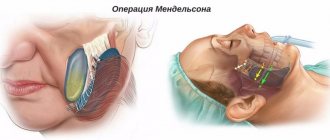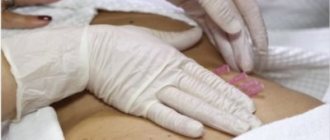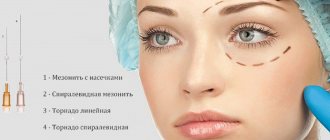Consultation with plastic surgeons with over 20 years of experience – free! Sign up by phone. Waiting for you! With age, a person's skin becomes less firm and elastic, excess skin appears, which can be a consequence, among other things, of severe weight loss. However traditional lipectomy
— a thigh lift operation is considered quite complex and labor-intensive; few surgeons, even in the West, undertake it and few people dare to carry it out.
The Mont Blanc Clinic offers you an alternative method of lipectomy. Its difference from traditional surgery is that after the mandatory liposuction procedure, excess skin is not excised, but distributed. As a result of the operation, the desired effect is achieved, but the rehabilitation period is much faster and easier, and the possibility of complications is eliminated. In Moscow, Mont Blanc is the only clinic that uses this exclusive method of performing thigh lifts.
FEMOROPLASTY (HIGH LIFT)
Everyone is crazy about Marilyn! Beauty Monroe captivated hundreds of thousands of men, thanks not only to her gentle voice, but also to her hips! The star proved that if you keep yourself in good shape, men will fall at your feet much more willingly! A beautiful figure has long fascinated men all over the world. But, if earlier young ladies hid behind closed clothes, and it was almost impossible to admire their silhouette, today girls prefer dresses and suits that favorably emphasize the curves of the body. thigh lift - femoroplasty will come to the rescue .
Femoroplasty thigh . A thigh lift is performed for those patients whose skin on the thighs sag in unsightly folds. These skin folds can be either a consequence of sudden weight loss or natural aging of the body, or the result of “failed” liposuction (when, after removing large volumes of fat, the patient’s skin did not shrink).
In cases of sagging skin on the outer thighs, one of the types of surgical lifting is performed in combination with a buttock and/or abdominal lift. This type of large, voluminous surgical intervention is called body lifting.
The purpose of this surgical intervention is to remove excess unabridged, overstretched skin and form a new contour of the inner thighs.
PREOPERATIVE MARKING AND SELECTION OF ENDOPROSTHESIS
Accurate and competent preoperative marking largely determines the success of gluteoplasty. That is why the specialist takes a very responsible approach to marking. He carefully takes all the necessary measurements, taking into account every centimeter and taking into account the shape of the buttocks and the anatomical areas surrounding them.
Currently, surgeons use various methods of preoperative marking and arthroplasty techniques. In this case, we performed gluteoplasty using a method developed by a renowned doctor from Brazil, a member of several international associations of plastic surgeons, Dr. Raul Gonzalez. The technique he proposed was called the XYZ method of placing an implant in the thickness of the gluteus maximus muscle.
We begin preparing for gluteoplasty with markings, having previously determined the points at which the pelvic bones connect to the hip bones and spine. The above points serve as a kind of guidelines that allow you to apply the markings correctly. The patient is in a standing position during marking.
The first step is to draw a point marking the upper border of the intergluteal fold. Next, we find by touch the iliac crest and the place where it meets the upper outer point of the sacrum (we determine the sacral dimple). After this, we measure 5 cm from the sacral dimple along the iliac crest and mark the G point. The next step is to draw a line marking the border of the gluteus maximus muscle. This line starts from the G-spot and runs all the way to the greater trochanter (trochanter) of the femur. Then we mark three points located where the ischial tuberosities and the lower part of the coccyx are located. We draw a line through these three points: it will indicate the lower border of the gluteus maximus muscle.
Before installing the implant, we will make sure that it will fit within the boundaries of the gluteus maximus muscle. In this case, we will take into account both the thickness of the muscle and the thickness of the subcutaneous fat layer in a given area of the body. We pinch the skin and subcutaneous fat layer between two fingers (pinch test): if the distance between the fingers is 2 cm, then the actual thickness over the prosthesis will be equal to half the result of the pinch test, namely 1 cm. In addition, you need to remember and about the thickness of the muscle that will cover the endoprosthesis. We are talking about another 1.5-1 cm.
Rice. 9. Marking
As a rule, round prostheses with a base width of 11 to 12.5 cm and a volume of 200-300 ml are used for gluteoplasty (except for cases where the patient has “non-standard” buttock sizes). At the same time, you need to remember that the dimensional grid of manufacturers is not the same, so a particular width of the base may correspond to a different volume. The parameters that determine the choice of a drop-shaped (anatomical) implant are their width and height. Depending on what aesthetic result the patient wants to see after the operation, we choose a prosthesis with a low, medium or high profile (projection). The higher the value of this parameter, the more convex the buttocks will look in profile.
In this particular case, the choice was made in favor of round endoprostheses with a volume of 275-300 ml. A sizer, or temporary implant, which we will place in a “bed” (a pocket created in advance), will help us select the material for buttock replacement with greater accuracy. All subsequent manipulations are performed on the operating table. The patient takes a prone position on his stomach.
Rice. 10. Implant layout diagram
LOCATION OF SCARS IN FEMOROPLASTY
- scars can be located in the groin folds (when minimal excess skin is removed),
- short incisions are made on the inner surface of the thighs (suitable for small excision of the skin, otherwise there is a risk of developing complications - the so-called “skin corrugation”),
- the surgeon creates one continuous long scar: from the groin to the knee (used for severe excess skin).
With femoroplasty, it is very important to clearly fix the scar to the dense tissues in the groin area (when making an incision only in the groin area) and reduce the load on it by multi-row suturing of the wound (there are also various methods and techniques for this).
REVIEWS ABOUT HIGH LIFT
“Today is the last check-up after the thigh lift. A year ago I had surgery at the Abrielle plastic surgery clinic. Now I’m very pleased with the result,” Oksana, 38 years old
Other reviews about thigh lift can be read here.
Preparation for surgical correction of the buttocks
You should start preparing with a consultation with a plastic surgeon. After conducting an examination, the doctor will listen to the patient’s complaints and wishes, make suggestions on the surgical technique, and report on the method of anesthesia.
Next, you need to undergo preoperative diagnostics. This is a mandatory step for every surgical procedure and allows you to identify health problems that may interfere with surgery.
The list of contraindications to buttock surgery includes:
- malignant processes;
- diabetes;
- heart and vascular diseases;
- bleeding disorders;
- infections of various origins;
- pregnancy, lactation, etc.
REHABILITATION PERIOD AFTER HIPM PLASTY
After a thigh lift, the patient spends 1-2 days in the clinic’s hospital, after which he can be discharged for outpatient observation and dressings.
In the first few weeks, hematomas (bruises) and swelling in the operated areas and decreased sensitivity may occur. The patient may also experience some discomfort when walking. All efforts of doctors during the rehabilitation period are aimed at ensuring that the scars remaining after the operation form correctly, stretch as little as possible and do not move.
In this regard, the patient must follow some rules and recommendations:
- mandatory wearing of compression garments for 2-3 months, in some cases (large volume of surgery) - longer;
- limitation of physical activity and exercise, exclusion of thermal procedures (visiting baths, saunas) in the first month after surgery.
After 3-4 weeks, the patient can return to his normal lifestyle. After 3-4 months, when the tissues are completely restored and the scar softens and brightens, it will be possible to fully evaluate the aesthetic result of the operation. The quality of the formed scar should be assessed no earlier than after 6-12 months.
Contraindications
Femoroplasty is not performed if there are restrictions such as:
- Phlebeurysm.
- Predisposition to thrombosis.
- Blood diseases, incl. poor clotting.
- Various neoplasms.
- Endocrine disorders.
- Infections and viruses.
- Gynecological diseases.
- Menstruation, as well as 4 days before and after it.
If the patient has the listed contraindications during preparation, then to eliminate the imperfections of the hips it is worth considering cosmetic and hardware techniques - SplitFat Sistem, mesotherapy,
RESULT AFTER HIGH LIFT
A thigh lift is not one of the most popular plastic surgeries. This is explained by the duality of the results obtained. On the one hand, the aesthetic problem has been solved (sagging skin and fat have been removed), but on the other hand, very long scars remain on the legs or arms, which, alas, do not make the patient more beautiful or his image more harmonious. What is better – skin hanging in folds or a slender body contour, but with a scar? Only the patient decides...
Enjoy life and look in the mirror with pleasure - your hips will look like in the picture! Being the owner of a beautiful figure and graceful curves of the body is like wings behind your back, and an inspired woman means a playful look, a great mood, self-confidence and self-confidence! Being desired by your man is hard work. After all, even the sweetest and most delicious dish will get boring over time. Therefore, we wish you to conquer your man not only with a delicious dinner, but also with seductive hips, which he will be crazy about
Progress of the procedure
Femoroplasty technology involves the use of general anesthesia. The correction usually lasts about three hours.
The operation begins with marking and an inhalation or intravenous anesthetic injection. After which incisions are made, the fat layer and excess skin are removed. The last step is suturing using the layer-by-layer method. When lifting the thighs, this point is important and the final result depends on it. Otherwise, tissue displacement or damage to the genital organs may occur.
First, the surgeon places internal sutures on the fascia of the thigh muscles, after which the skin is stitched with double threads. In this case, the edges of the dermis should not fit tightly to each other to avoid the appearance of rough keloid scars. The procedure ends with the installation of drainage tubes and application of a sterile dressing.
Price
The price includes:
- examinations;
- dressings;
- stay in the room and necessary things;
- anesthesia or anesthesia;
- nutrition.
The cost of the procedure depends on many factors
We will indicate the average cost of each procedure.
| Type of procedure | Cost of one procedure |
| Surgical butt lift | 95,000 rubles. |
| Filamentlifting | 120,000 rubles. |
| Lipofilling of the buttocks | 100,000 rubles. |
Complications
Thighplasty has an increased risk of complications. This is due to the long incision during surgery. Therefore, it is not as popular as liposuction.
If the rules of the restoration process are ignored or the surgeon acts incorrectly, the following side effects are likely:
- Seromas. They occur when fluid accumulates in the wound. Eliminated by repeated drainage.
- Loss of sensation. A temporary phenomenon that goes away on its own.
- Increased sensitivity. Hypertension persists for life.
- Infection, suppuration. Treated with antibacterial therapy.
- Displacement of the genital organs as a result of tension in the groin skin.
- Thrombosis. Caused by prolonged bed rest.
- Formation of keloid scars.
- Slow blood circulation at the incision sites. The cause is tissue overtension. May lead to necrosis.
- Disruption of lymphatic drainage. You feel constant heaviness and swelling in your legs, because... lymphatic vessels are damaged.










